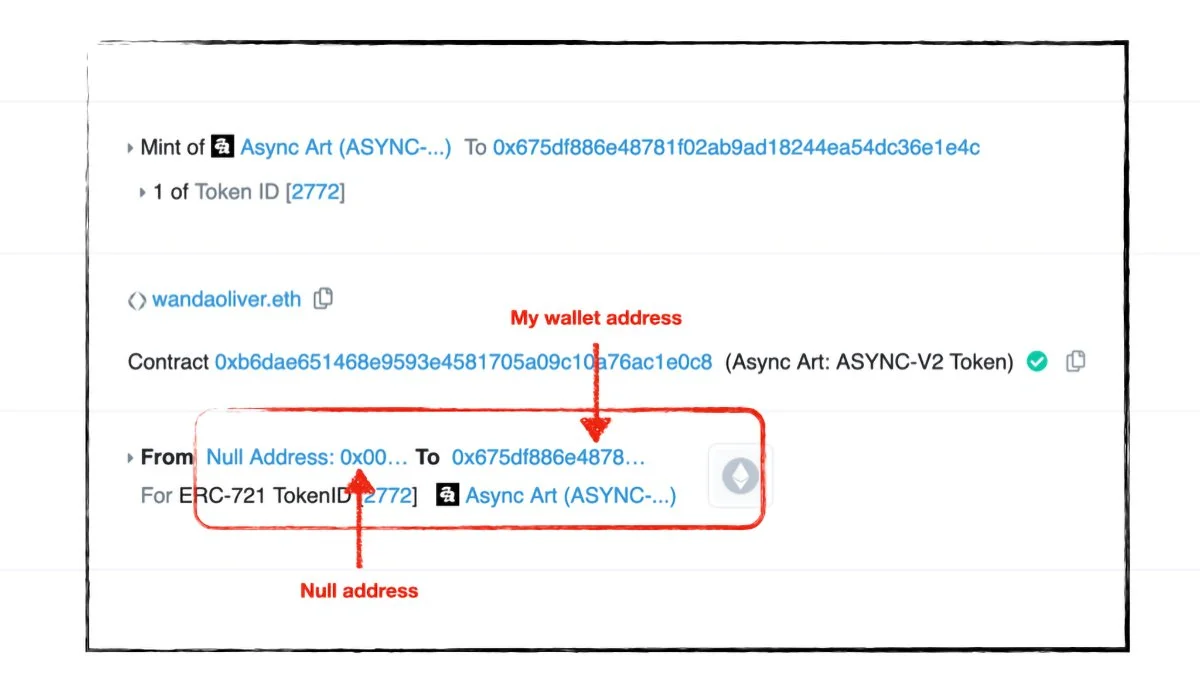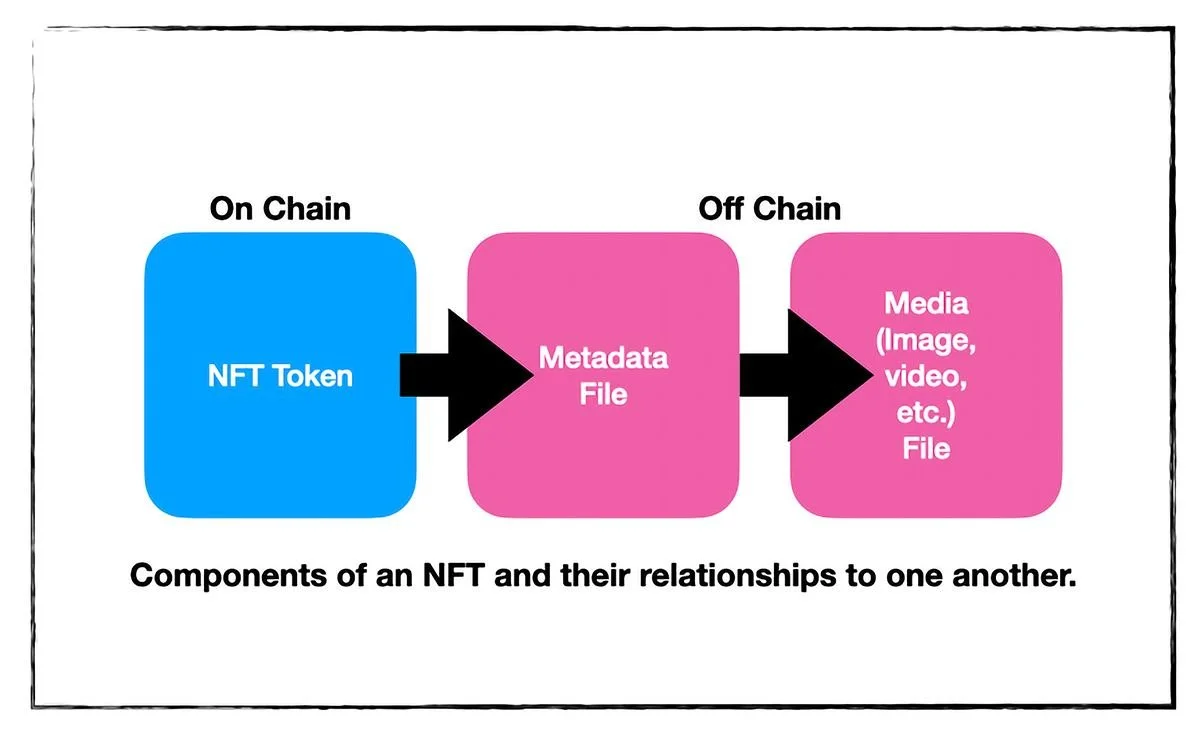TRUE PROVENANCE
Artwork by the author found on Async.art.
JANUARY 18TH, 2022
I recently published an article in which I pointed out immutable provenance as one of the most important benefits of NFTs to creators. Only days later, I read a Medium article that made me aware of an issue that affects that provenance. The author pointed out that on some platforms, minting is done using the wallet of the platform rather than the wallet of the creator. The result is that, as far as the blockchain is concerned, the artwork sprang from the head of Zeus - the creator is not referenced at all, and the chain of provenance starts with the platform. Concerned, I immediately set out to determine for myself whether this caution applied to my work.
I have work minted on five platforms, two on Ethereum, two on Tezos, and one on Stacks. What I discovered by digging in, was both reassuring and surprising. Two of my platforms, Async.art and kalamint.io, passed the test with flying colors. Examining the blockchain transactions on etherscan.io and tzkt.io (snippet from etherscan data on an Async.art mint below), I was able to confirm that the chain of provenance began at mint with my wallet address in both these cases.
Patrn.me operates on a unique model. Donations are made against a price goal set by the artist. When the goal is reached, the work is minted in an edition size equivalent to the number of patrns making a donation. The mint is done by Patrn.me, using their wallet address, on behalf of the creator. The only reference to the creator is found in the metadata, in the form of the patrn.me username. While there is much to admire about their model, I have to give them a fail on the issue of provenance. And that fail has further implications. Royalties on secondary sales of Patrn-based NFTs are paid by the smart contract to a Patrn.com wallet. The distribution of these royalties to creators is dependent on the Patrn platform, an unfortunate off-chain centralized dependence. See an example of one of my Patrn-based NFT artworks listed on Open Sea below, and note the fact that I am not present anywhere as the creator of the art. I have discussed and confirmed my findings with the Patrn.me team and I hope they will move quickly to make the changes necessary to address these unfortunate aspects of their offering. I do believe in the dedication and commitment of the team, and their genuine desire to support their artists. This is simply an oversight in a young platform.
In the case of HeyLayer.com, the nature of the provenance depends on how the artist chooses to use the platform. The platform supports minting without a wallet for artists new to the space and intimidated by the cryptocurrency elements. In that case, Heylayer mints under their own wallet address on behalf of the creator. If the artist connects a wallet, mints are done using that connected wallet address. Happily, HeyLayer allows the creator to define custom properties to be included in the NFT metadata, giving the creator the opportunity to add important information to the mint. This feature can be used to good effect by artists who want to mint without connecting a wallet. They can establish provenance for their art by adding an Artist Name property to their NFTs. I am currently using the custom properties feature to add Artist Name, Original Creation Date, and Licensing Terms to my Heylayer NFTs even though I do mint from my own wallet. Secondary sales are not yet available on HeyLayer. I am confident, however, given my discussions with the team that they are committed to strict adherence to standards and cross-platform interoperability in the Stacks ecosystem, and that royalties for artists whose work is minted under the Heylayer wallet will be protected. We will have to pay close attention to the details as the ecosystem fleshes out.
Objkt.com presented a different problem altogether. I was established at mint as the creator of the work, but I discovered to my chagrin that the NFTs I minted on objkt.com do not appear correctly in my wallet or on the Tezos block chain explorer, tzkt.io. There seems to be some incompatibility in the metadata associated with these items, leaving them without any visual reference and stripped of details as basic as the title of the NFT. Only on the objkt,com platform was I able to see the NFTs I had minted, and collected there from other minters, in full detail. That discovery led me to the realization that true provenance depends as much on properly constructed and stored metadata as upon the proper identification of the creator.
Metadata and Provenance
Having my wallet recorded in the Mint transaction as the originator of the art provides an important on-chain digital signature and origin point for the provenance of the work. However, it does not provide any meaningful context to enrich that provenance. That duty is left to the metadata. An intact and durable NFT requires three permanent, decentralized, and immutable components: 1) the on-chain ledger entries that record transactions related to the NFT, beginning with the mint, 2) the metadata that provides critical descriptive information about the NFT, including the link to the media file(s) that comprise the actual artwork, and 3) the actual artwork.
If either of the two latter elements are lost, the integrity of the NFT is lost. One might be able to use the blockchain to trace the history of the NFT, but there is little comfort in knowing that an artwork of some sort once existed, was valued, and traded, if the connection between the history and the art is lost. The information on-chain is inherently permanent, decentralized, and immutable, but the metadata and actual artwork can be much less so. To ensure true provenance of your work, it is vitally important that artists understand how the minting platforms they use handle each of these components.
In working through these examples, I confirmed the validity of the caution I had read, and I became aware of important nuances that I had not previously given much thought. The examples are obviously not exhaustive, but they are illustrative of the important differences that can occur across platforms, and the need for creators to examine these details closely.
Our industry is young. The tools and platforms we use are young. With the best intentions of the founders and developers, there can be gaps and unintended consequences of software design and process workflow decisions. It is incumbent on us all to work together to find the gaps in our common vision and close them. Don’t be shy. Jump on the Discords. Ask questions. Dig in. Let your voice be heard.




